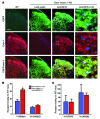Mediation of opioid analgesia by a truncated 6-transmembrane GPCR
- PMID: 26011641
- PMCID: PMC4563690
- DOI: 10.1172/JCI81070
Mediation of opioid analgesia by a truncated 6-transmembrane GPCR
Abstract
The generation of potent opioid analgesics that lack the side effects of traditional opioids may be possible by targeting truncated splice variants of the μ-opioid receptor. μ-Opioids act through GPCRs that are generated from the Oprm1 gene, which undergoes extensive alternative splicing. The most abundant set of Oprm1 variants encode classical full-length 7 transmembrane domain (7TM) μ-opioid receptors that mediate the actions of the traditional μ-opioid drugs morphine and methadone. In contrast, 3-iodobenzoyl-6β-naltrexamide (IBNtxA) is a potent analgesic against thermal, inflammatory, and neuropathic pain that acts independently of 7TM μ-opioid receptors but has no activity in mice lacking a set of 6TM truncated μ-opioid receptor splice variants. Unlike traditional opioids, IBNtxA does not depress respiration or result in physical dependence or reward behavior, suggesting it acts through an alternative μ-opioid receptor target. Here we demonstrated that a truncated 6TM splice variant, mMOR-1G, can rescue IBNtxA analgesia in a μ-opioid receptor-deficient mouse that lacks all Oprm1 splice variants, ablating μ-opioid activity in these animals. Intrathecal administration of lentivirus containing the 6TM variant mMOR-1G restored IBNtxA, but not morphine, analgesia in Oprm1-deficient animals. Together, these results confirm that a truncated 6TM GPCR is both necessary and sufficient for IBNtxA analgesia.
Figures



Comment in
-
A new splice of life for the μ-opioid receptor.J Clin Invest. 2015 Jul 1;125(7):2558-61. doi: 10.1172/JCI82060. Epub 2015 May 26. J Clin Invest. 2015. PMID: 26011639 Free PMC article.
Similar articles
-
Truncated μ-Opioid Receptors With 6 Transmembrane Domains Are Essential for Opioid Analgesia.Anesth Analg. 2018 Mar;126(3):1050-1057. doi: 10.1213/ANE.0000000000002538. Anesth Analg. 2018. PMID: 28991118 Free PMC article.
-
Tetrapeptide Endomorphin Analogs Require Both Full Length and Truncated Splice Variants of the Mu Opioid Receptor Gene Oprm1 for Analgesia.ACS Chem Neurosci. 2016 Dec 21;7(12):1717-1727. doi: 10.1021/acschemneuro.6b00240. Epub 2016 Oct 10. ACS Chem Neurosci. 2016. PMID: 27648914 Free PMC article.
-
Truncated mu opioid GPCR variant involvement in opioid-dependent and opioid-independent pain modulatory systems within the CNS.Proc Natl Acad Sci U S A. 2016 Mar 29;113(13):3663-8. doi: 10.1073/pnas.1523894113. Epub 2016 Mar 14. Proc Natl Acad Sci U S A. 2016. PMID: 26976581 Free PMC article.
-
Alternative Pre-mRNA Splicing of the Mu Opioid Receptor Gene, OPRM1: Insight into Complex Mu Opioid Actions.Biomolecules. 2021 Oct 15;11(10):1525. doi: 10.3390/biom11101525. Biomolecules. 2021. PMID: 34680158 Free PMC article. Review.
-
Exploring Pharmacological Functions of Alternatively Spliced Variants of the Mu Opioid Receptor Gene, Oprm1, via Gene-Targeted Animal Models.Int J Mol Sci. 2022 Mar 10;23(6):3010. doi: 10.3390/ijms23063010. Int J Mol Sci. 2022. PMID: 35328429 Free PMC article. Review.
Cited by
-
Abuse Liability, Anti-Nociceptive, and Discriminative Stimulus Properties of IBNtxA.ACS Pharmacol Transl Sci. 2020 Jul 27;3(5):907-920. doi: 10.1021/acsptsci.0c00066. eCollection 2020 Oct 9. ACS Pharmacol Transl Sci. 2020. PMID: 33073190 Free PMC article.
-
Advances in attenuating opioid-induced respiratory depression: A narrative review.Medicine (Baltimore). 2024 Jul 19;103(29):e38837. doi: 10.1097/MD.0000000000038837. Medicine (Baltimore). 2024. PMID: 39029082 Free PMC article. Review.
-
Pharmacological Characterization of Levorphanol, a G-Protein Biased Opioid Analgesic.Anesth Analg. 2019 Feb;128(2):365-373. doi: 10.1213/ANE.0000000000003360. Anesth Analg. 2019. PMID: 29649035 Free PMC article.
-
Synthesis and Pharmacology of a Morphinan-Derived Dual Mu-Kappa Opioid Receptor Agonist Analgesic.ACS Chem Neurosci. 2025 Jul 16;16(14):2714-2737. doi: 10.1021/acschemneuro.5c00312. Epub 2025 Jun 26. ACS Chem Neurosci. 2025. PMID: 40566691
-
Structural and functional interactions between six-transmembrane μ-opioid receptors and β2-adrenoreceptors modulate opioid signaling.Sci Rep. 2015 Dec 11;5:18198. doi: 10.1038/srep18198. Sci Rep. 2015. PMID: 26657998 Free PMC article.
References
Publication types
MeSH terms
Substances
Grants and funding
LinkOut - more resources
Full Text Sources
Molecular Biology Databases
Research Materials

